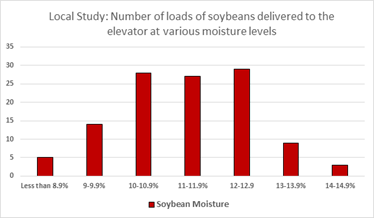ILSOYADVISOR POST
When Should I Harvest My Soybeans?
Four years ago, I entered a field in the Illinois Soybean Association 100-Bushel Challenge. The field was an early planted full-season variety. To say they looked great was an understatement. They had a good stand, good branching, and, most impressive of all, great pod counts. Unfortunately, the year turned dry at the end and my plants wound up dropping about 30% of their pods. My full season maturity hurt me.
They still looked good (not great), so I decided to enter them into the contest. I had hoped to cut them at the end of the week, but due to scheduling with the official to certify the entry it had to wait until the next week. When I cut them, they were over dry and had quite a bit of head shatter. When the driver got back from the elevator, the math worked out to 73 bushels per acre and 9% moisture. The contest official said, “Well, we calculate all yield to 13% moisture so after we account for that your entry yielded just over 76 bushels per acre.” That was when it dawned on me—I was losing a lot of money due to over-dry soybeans.
I have farmed and worked for and worked with farmers most of my life. Every fall, I see growers trying to avoid a lot of dock waiting for soybeans to hit 13.5% moisture and start cutting. It never fails, by the end of harvest they are sending 9% soybeans to the elevator. If our goal is to maximize net revenue, this is not an effective strategy. The University of Nebraska did a study looking at what percentage of loads to the elevator at various moisture levels and the yield reduction due to moisture. The results confirm what I have seen for years.

Source: https://cropwatch.unl.edu/2017/plan-harvest-deliver-soybean-optimum-mois...

Source: https://cropwatch.unl.edu/2017/plan-harvest-deliver-soybean-optimum-mois...
It is certainly worth noting that these numbers do not include any additional harvest losses. At 9% vs. 12% you conservatively lose an additional 2-3% of yield to shatter. The reality of my example in the Yield Challenge was that with 2% extra harvest loss my entry should have made 78 bushels per acre if harvested sooner. That’s 6.4% or $50/acre in missed revenue, and it happens on tens of millions of acres every year.
So, what about price dock for shipments that are too wet? The University of Nebraska put together this table as a guide:
13.1% to 13.5% moisture — 1.5% price dock
13.6% to 14% moisture — 3% price dock
14.1% to 14.5% moisture — 4.5% price dock
14.6% to 15% moisture — 6% price dock
If I would have cut those same soybeans at 15% moisture, I would have netted more income and had a higher APH to insure against.
I understand that mentality is hard to break, but the math is there to support it. Especially if you have a landlord getting a share of the crop, they may not be as understanding of moisture dock on the elevator settlement sheet. It is worth noting that if soybean harvest is not done by the time the weather turns for the winter, it is extremely difficult. Harvest timing is an extremely personal matter. For me, if I am starting in the morning at 14.5% moisture, I am cutting. That allows me to keep more bushels and give up less in harvest losses.





Comments
Add new comment